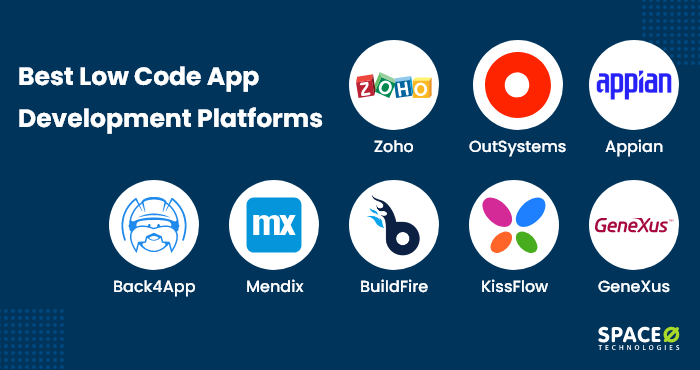Good Info For Deciding On Low-code platforms for application development
Good Info For Deciding On Low-code platforms for application development
Blog Article
In Terms Of Integration Capabilities, Low-Code Application Development Has A Lot Of Advantages.
Low-code application integration offers many advantages, including the ability to seamlessly integrate various applications and systems. Here are some of the key benefits: Prebuilt Connectors & APIs
A Wide Variety of Connectors : Low-code platforms generally come with a huge collection of pre-built connectors for common enterprise systems (e.g. ERP, CRM, databases, and cloud services). Integration is made easier.
API Integration: A lot of low-code platforms provide out-of-the-box API integration features, allowing developers to connect to external services and data sources quickly.
User-Friendliness
Drag-and-Drop Interfaces: Several integration tasks can be easily completed using drag-and–drop interfaces. This makes it feasible for developers and others who are not developers to create complex systems without lengthy programming.
Visual Workflow builders Visual Workflow Builders utilized to design workflows, data flows and integrations. They aid in understanding and establishing them more intuitively.
Standardized Integration Methods:
SOAP and Restful Service: Using standard web service protocols such as SOAP and REST makes it easy to integrate with external systems and applications.
OData, Other Standards: The support for standards such as OData helps to access and manipulation data across platforms and applications.
Real-Time Data Synchronization:
Real-time Integrations: Low-code platforms allow real-time data synchronization between applications and systems, assuring that data is always current and consistent across the organization.
Event-Driven Architect: Certain platforms are equipped with events-driven structures, allowing applications to respond instantly to events. This is crucial for dynamic interactive applications.
Legacy System Integration:
Low-code platforms are a great source of software to connect with existing systems. They enable organizations to modernize IT without overhauling their existing systems.
Data Migration Tools: The built-in tools to migrate data facilitate the transfer of data from older systems to applications developed using low-code platforms.
Third-Party Integration of Service:
Cloud Services: Seamless Integration with Cloud Services such as AWS Azure Google Cloud and Google Cloud allows for easy deployment of applications.
Business Applications Integration: Low-code platforms are able to be integrated with other business software like Salesforce, SAP and Microsoft Dynamics. This facilitates seamless flow between different business functions.
Simplified Data Management:
Data models that are unifying: A few platforms that offer low-code support for unified models of data to simplify data management across systems.
Data Connectors: Data connectors that are pre-configured to permit easy access to and manipulation of data from various sources.
Security and Compliance:
Low-code platforms make sure that integrations are compliant with security protocols and standards, protecting data in transit and while it is in its rest.
The platforms include features to ensure that integrations are compatible with the regulatory standards.
Extensibility:
Low-code platforms are able to accommodate complicated integration requirements by incorporating custom scripts or code. They provide flexibility, without compromising the user-friendliness.
Plug-in Ecosystem An ecosystem of extensions and plugins can increase the capabilities of integration that allow users to include new functions as needed.
Low-code platforms are a powerful instrument to create interconnected robust and scalable applications. They are able to streamline the process for connecting different systems and improve the flow of information. Businesses can also leverage existing technologies and adopt new ones while maintaining a cohesive IT environment. Read the recommended read this for Low-code Platform for application development for website examples including software for app development, cross platform app development, ms azure sql, database in azure, rapid application design, cross platform mobile dev, develop web app, app modernization, ms azure sql, push notifications and more.
Benefits Of Low Code Application Development For Governance And Security
Low-code development of applications offers a variety of advantages when it comes to security and governance, both of which are essential for ensuring that the application is compliant, secure, and well-managed throughout their entire life cycle. Below are the advantages of developing applications using low-code:
Unified Manage Console: Lowcode platforms generally have a management console which allows administrators to manage and supervise applications.
Role-Based Access Control: These platforms have robust control based on roles that lets administrators define rules and enforce these policies. This ensures only authorized users are able to access or modify specific parts of the app.
Compliance and Regulatory Adherence
A lot of low-code platforms come with built-in compliance features. They are built to meet industry standards and regulations like GDPR or HIPAA. These platforms have frameworks and tools that ensure that the applications are compliant with these requirements.
Audit trails and logs Audit trails that are comprehensive and logging are usually integrated. This allows organizations to track and monitor changes and access, as well as to ensure conformity with internal rules as well as external regulations.
Increased Security Measures:
Data encryption. Low-code platforms provide encryption built in for data both at rest and while it is being transmitted, which ensures sensitive information remains protected.
Security Certifications Many low-code sellers have security certifications (e.g. ISO 27001, SOC 2 ) that demonstrate the compliance with security standards of high quality. This adds additional confidence to users.
Automated Security Updates
Regular Security Updates and Patches : Low-code platform handle automatically security patches, updates and updates. Thus, applications are protected from the latest threats without requiring developer intervention manually.
Security Monitoring: Continuous security monitoring tools are typically provided, providing immediate alerts and insight into security risks that might be present.
Data Governance
Data Access Policies: These tools allow organizations to define the data access policies, enforce them and keep track of policies. This ensures that data are only accessible by authorized users and are used in the correct manner.
Data Masking Anonymization The built-in tools for data masking and features for anonymization help safeguard sensitive data, particularly during development and testing environments.
Continuous application lifecycle management
Pipelines for development and deployment: Low-code platforms offer integrated development and deployment, which includes security tests. This guarantees security throughout the entire lifecycle of the application.
Version Control. The integrated version management system helps track and reverse any changes made to the application, making sure that the integrity of it is maintained.
User authentication:
Single Sign-On: Support for SSO as well as other sophisticated authentication methods eases managing users and increases security.
Multi-Factor Authentication A number of platforms are equipped with built-in functionality for multi-factor verification and provide an additional layer of security.
Policy enforcement and Compliance Monitoring:
Low-code platforms have templates for policies predefined and can aid organizations in implementing security and governance policies as well as governance policies.
Tools for Compliance Monitoring: These tools track and provide continuous reports on compliance status. They make it easier to identify problems and address the issues in a proactive way.
Integration into Existing Security Infrastructure
Seamless Integration: Platforms using low-code have been built to integrate seamlessly with existing tools and infrastructure, such as SIEM (Security Information and Event Management solutions) and firewalls.
API Security API Security Features: Built-in API security functions make sure that integrations with external systems are secure, securing the integrity of data as well as ensuring that applications remain secure.
Training and Best Practices
Guided Best Practices : A lot of platforms provide guidelines and best practices to assist non-developers comply with security standards.
Security Training Some low code providers offer security resources and training to users to educate them on how to build and maintain secure applications.
The security and governance features of low-code apps ensure they are managed and built in a regulated and compliant manner. These platforms are equipped with the frameworks, tools and regulatory compliance needed to secure sensitive data of customers and enforce policy. They also maintain regulatory conformity and ease the administration and supervision of the development process. Check out the recommended read this for Legacy application modernization with Low-code for blog examples including application modernization, application development platforms, rad development, ms azure sql, rapid application design, develop mobile application, azure sql, azure sql server, stored sql procedures, rapid applications and more.
Low-Code Apps Have Many Advantages In The Area Of Collaboration And Workflow
Low-code development can offer many benefits in collaboration and workflow. This makes it a great solution for businesses looking to boost productivity and simplify the development process. These are the primary benefits.
Unified Development Environment: Low-code platforms offer a unified, single environment where team members such as developers, business analysts, designers, and stakeholders are able to collaborate effectively. This helps to eliminate silos and promotes better communication.
Visual Development: The low-code platform's visual drag-anddrop capabilities make it easy for nontechnical team participants to participate to the design process. It also ensures business requirements are accurately gathered and then implemented.
Communication Enhanced
Real-Time Collaborative Features: A lot of platforms using low-code have real-time collaboration features, such as comments, editing, and immediate feedback. These features facilitate the communication process and decrease time spent on back and forth discussions.
Shared Workspaces Teams are able to collaborate by sharing workspaces. These workspaces allow them to view, edit and collaborate on elements of the project.
Streamlined Workflow
Built-in tools for managing projects Lowcode platforms usually come equipped with tools integrated to assist teams in planning, tracking, and directing their growth. This includes the assignment of tasks, progress tracking, deadline management and more.
Workflow Automation Automating repetitive tasks or workflows allows teams to concentrate their energy on more strategic initiatives and tasks, improving the overall efficiency of the company.
Faster Iteration:
Rapid Prototyping: Low-code platforms facilitate rapid prototyping and iterative design which allows teams to create tests, refine, and test applications in shorter cycles. This allows for rapid feedback and improvement.
Agile Development Support: Supporting agile methodology lets teams and individuals work in smaller increments. It can also allow you to rapidly adapt to changes.
Accessibility for non-developers:
Citizen Development: Low-code platforms enable business users (citizen developers) to create and modify applications without requiring a lot of coding experience. This eases the burden on IT as well as development teams and allows for quicker response to business needs.
Training and onboarding. Intuitive tools and extensive training resources help new team members get acquainted increasing the overall quality of collaboration.
Centralized Knowledge Sharing and Documentation:
Integrated Documentation: Low-code systems usually include features to maintain and create documents within the platform itself making sure that all project information is easily accessible and centrally located.
Knowledge Repositories : Teams can create knowledge repositories. These include templates, best practices, and reusable components. This helps in sharing knowledge and reduces duplication of efforts.
Consistency, Standardization and Standards:
Standardized components: Standardized components, built in advance, ensures uniformity in the applications. Team members can comprehend and work better with different components.
Governance and Governance and Compliance: Built-in frameworks for governance ensure that each development follows the organizational guidelines and regulations which reduces the risk of non-compliance and ensuring that applications meet the quality standards.
Feedback loops:
Integrated Feedback mechanisms: Low-code platforms usually have an integrated feedback mechanism, which allows users to easily give feedback on applications. Feedback can then become incorporated into development.
Continuous Improvement: The capacity for applications to iterate quickly and implement changes based off of user feedback, making sure that they are in tune with the requirements of the user as well as business objectives.
Visualization and Reporting
Real-Time Analyses: Built-in reporting and analytics tools give instantaneous insight into the project's performance, progress and user interaction, allowing for data-driven decisions.
Visual Workflow mapping: Visual tools used to map workflows can be utilized by teams to optimize workflows. This helps them identify bottlenecks and areas to improve.
Low-code development can offer many benefits in terms of workflow and collaboration. It allows for the integration of diverse teams together, streamline processes, simplify communication and improve collaboration. This fosters a more collaborative and efficient development environment that ultimately leads to higher-quality applications and better alignment with business objectives.